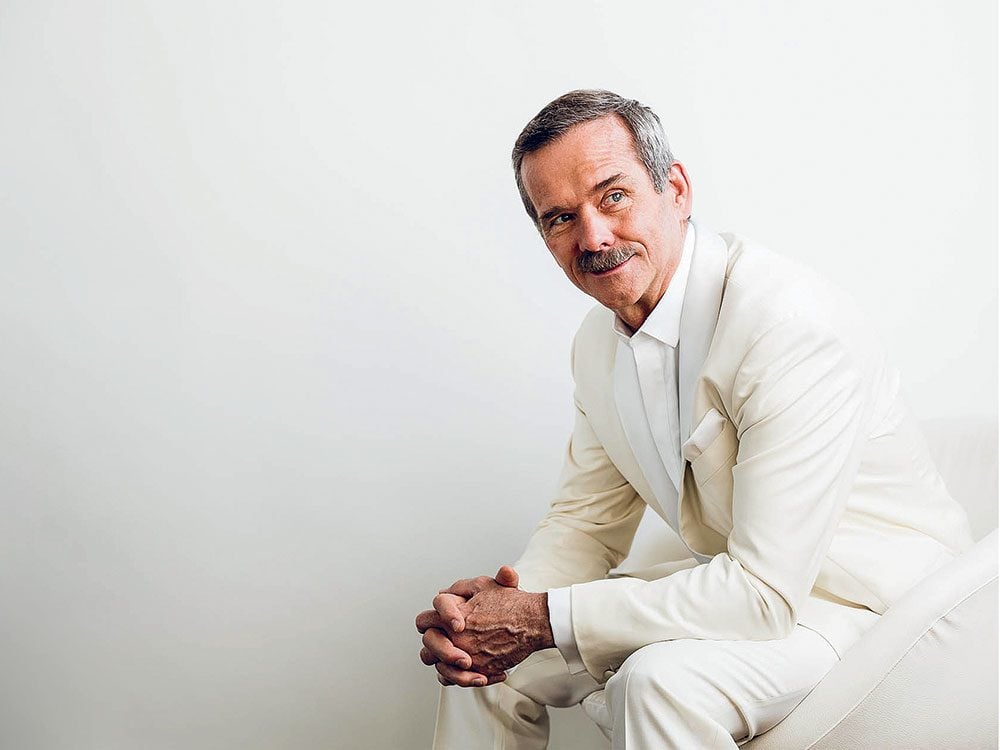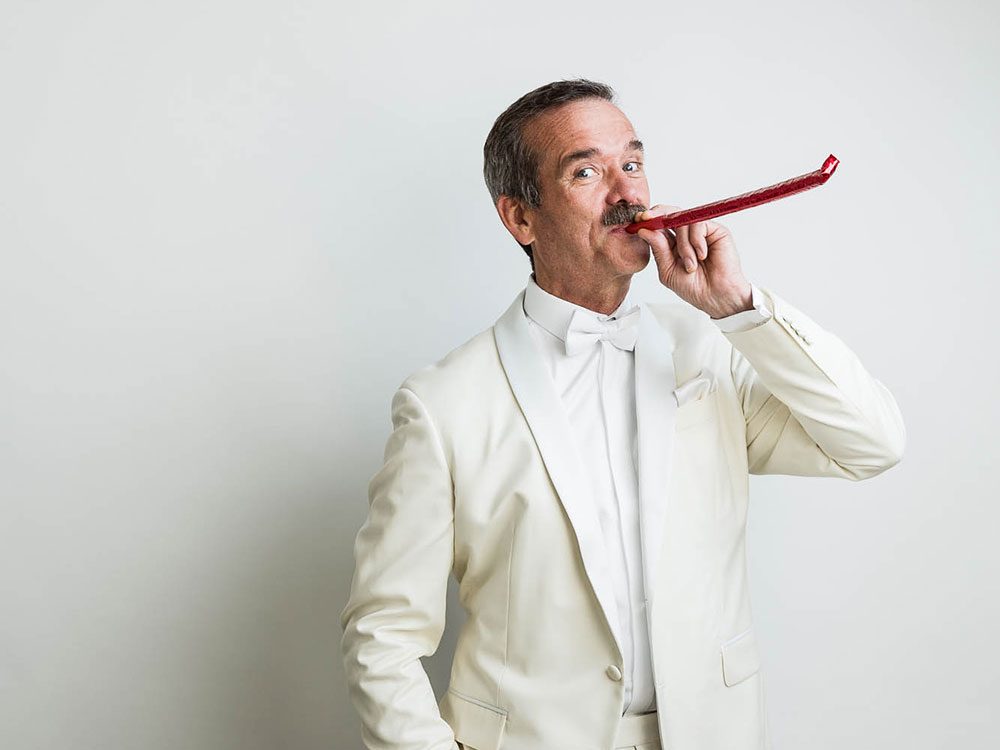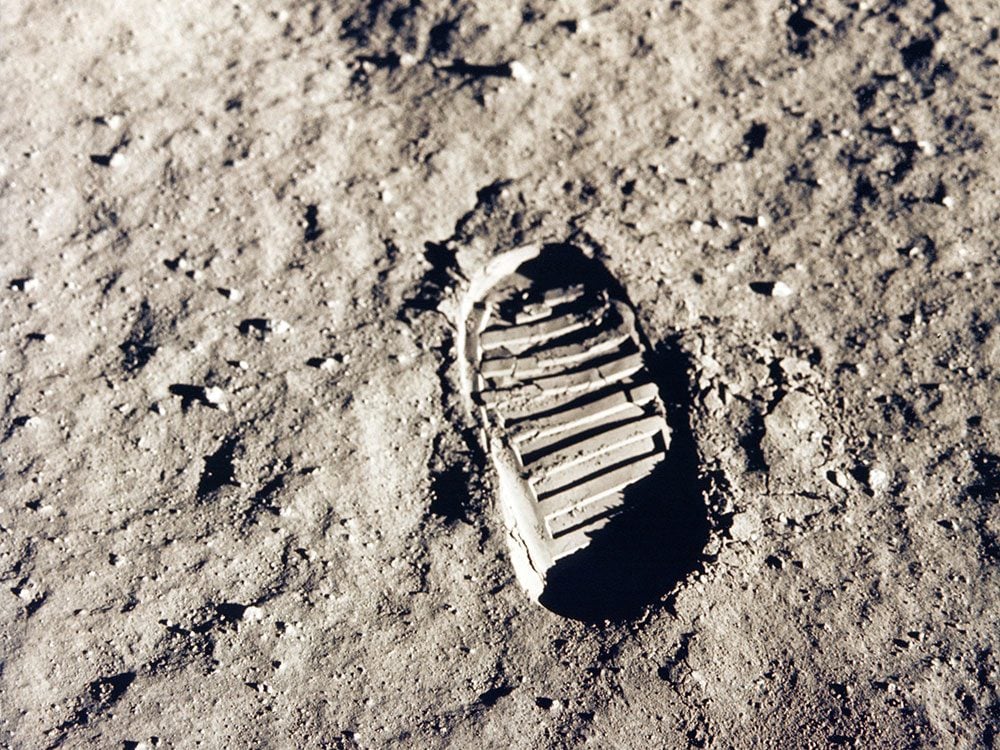
Chris Hadfield’s Gift to Canada
If Chris Hadfield could give every Canadian a gift to mark the country’s sesquicentennial, it would be the chance to see the nation from space, and not just because the view is fantastic. Having the opportunity to peer down at Canada—not all at once, but so that the whole view might fit on a panoramic screen—has given him a valuable perspective.
“It takes about eight minutes, not much longer than it does for me to describe it,” he says. And then he does describe it, tracing the route as he recalls it from the International Space Station, from just south of where the Fraser River flows into Vancouver all the way across to the western tip of Cape Breton Island.
He’s exaggerating slightly: Hadfield’s play-by-play lasts just under two minutes, and that’s including impromptu geography lessons (“The Manicouagan Crater is a bullet hole on the world from a couple million years ago”), poetic digression (“All those places where my great-grandfather dreamed, lost and won,” he says, describing how he feels gazing at the Prairies) and a sound effect (“Ploop!”) to highlight the spot where the St. Lawrence drops into the Atlantic. For Hadfield, seeing his homeland from this vantage point, “across distance and across time,” creates an intimacy (his word) that deepens with every orbit.
The relationship is not exclusively celestial. Over his 21 years with the Canadian Space Agency, Hadfield spent 166 days in space, versus thousands as a public figure—travelling from big cities to remote Arctic fishing communities, giving speeches and getting to know Canada’s nooks and crannies at ground level. He compares these experiences to looking at many tiny patches of fabric close up. From space, on the other hand, you see everything as one giant, metaphysical quilt. “All of it,” says Hadfield, “is Canada. The history, the people who are here now, the problems we face, the things we do great, the things we do terribly, the Leafs winning last night—all of it is part of our country.” And, of course, so is Chris Hadfield.
As the first Canadian to walk in space, the first to operate both Canadarms, the country’s first commander of the International Space Station, Hadfield has earned a place in the history books. Still, if he’s taken anything away from his time floating in the cosmos, it’s how much more he wants to contribute here on earth.
When you’ve surveyed the world from 400 kilometres up, you can’t help but be acutely aware of how piddly you are in the bigger picture—but you’re also reminded that there is a bigger picture, and that we are all part of it. It’s this sense of enduringness, of being connected to a grand progression, that Hadfield wants Canadians to think about as we wave flags and shoot fireworks up into eternity. “The better you understand all of Canada and how Canada fits in with the rest of the world,” he says, “the better chance you have of understanding what your actions should be and how they affect others.” Astronauts, he adds, are privileged enough to have a global perspective, one he urges his fellow citizens to consider. “It’s all to try to help people see the reality of our planet.”

At Home With Chris Hadfield
Hadfield’s tendency to express himself like a musician testing out lyrics can make you forget that he is, above all, a man of science. He dismisses the suggestion that there’s something mystical happening up there among the stars. He thinks birthdays are great, but only if you use them as an occasion to contemplate how to move forward by looking back. In the case of Canada, that means reflecting on far more than 150 years.
“Try four billion,” Hadfield says. That’s the age of fossils found by a team of geophysicists earlier this year in the Nuvvuagittuq Greenstone Belt, on Hudson Bay, specimens that contain the oldest evidence of life on this planet. “The earth was just cooling down!” he marvels in a way that suggests these statistics mean something to him, which of course they do. Hadfield understands the history of his home planet the way most people understand the plot points of their favourite movie. “Go around the world a few thousand times and you start to realize the toughness of it, your place in it,” he says. By way of example, he gestures upward: “Right here, where we’re sitting, had a mile of ice above us just 15,000 years ago!” Just 15,000 years.
Where we are sitting is in the kitchen of his home in Toronto’s High Park neighbourhood, where he lives with his wife, Helene, and their pug, Albert. The Hadfields, who both grew up in Oakville, Ont., are high school sweethearts, and if you think Hadfield waxes poetic about Canada, you should hear him talk about his wife, whom he calls a “true partner” and the reason he’s been able to have his stunning career. The couple has three children in their early 30s—Kyle, Evan and Kristen, who live in China, Canada and England, respectively.
Their house is cozy and unassuming, full of personal touches, like Helene’s artwork (a giant portrait of Snoopy in his “Joe Cool” persona), letters from young fans on the fridge and two rows of a dozen or so small plants, which I take to be a science experiment (in fact, they’re just decorative).
Clad in a T-shirt and track pants, Hadfield might be a cadet heading out for morning drills, though his bleary-eyed gaze suggests he could probably use a nap. Instead, he sips coffee. When I ask who has the green thumb, he jokes that if it depended on him, the plants would be long gone. Hadfield has lived in Toronto for three years now, but he’s had precious little downtime since he and Helene relocated from Houston after his retirement in 2013. When I tell him it’s a treat for me to be in his home, he responds, “It is for me also.” This time, he’s not exaggerating.
He flew in for our meeting from London, England, where he spent several weeks shooting a BBC series called The Toughest Job in the Universe (kind of like The Apprentice for astronauts). The next day he was on a plane to New York to promote his interactive documentary, Miniverse—which is available for viewing on Curiosity Stream—on the Today show. Between larger commitments, he makes time to Skype with children’s classes for a learning program called On the Lunch Pad, hosts charity events and, occasionally, appears as a motivational speaker.
Even his leisure activities are awe-inspiring: he’s performed on guitar with several orchestras, including a collaboration this past spring with the Victoria Symphony. Last summer, he joined a group of 12, including artists and other creative types, on an 18-day Arctic expedition, where they recorded an album of original music, including one of Hadfield’s own compositions, which he wrote in Russian. (Hadfield is fluent in the language, which he studied for 20 years; he also worked as the director of operations for NASA at the Yuri Gagarin Cosmonaut Training Center in Moscow between 2001 and 2003.)
“I feel better when I have done something in a day than if I’ve done nothing,” he proclaims, stating the obvious. When I say I’m surprised to hear he’s ever gone a full day without accomplishing anything, he admits he probably has not.
It’s one of the first beautiful spring mornings; weather that holds the promise of patio season and lazy weekends—for most of us. “I could sit on the back porch sipping coffee,” says Hadfield, “but I think it’d be somewhat of a waste. I’ve been inspired by a lot of people over the years, and if they’d just sat on the porch, they wouldn’t have inspired me.”
That list of role models starts with Alexander Graham Bell—a Canadian not by birth “but by choice,” says Hadfield, who admires the communications pioneer’s drive. “An absolutely relentless intellect,” is how he describes Bell, a man who used his dissatisfaction with the way things were as a catalyst to expand his own abilities to solve those problems. In his 2013 book, An Astronaut’s Guide to Life on Earth, Hadfield explains he’s always been motivated by frustration with his own level of incompetence.
It’s a philosophy that was imparted by his father around the family dinner table when Hadfield, the second youngest of five, was growing up on a farm in Milton, Ont. If a question arose that nobody could answer, whichever kid had posed it was expected to grab a volume of the Encyclopedia Britannica they’d bought at the Canadian National Exhibition from the bookshelf. “You don’t sit around and not know stuff,” Hadfield says.

What Inspires Chris Hadfield?
When Neil Armstrong took that single, monumental small step onto the lunar surface, Hadfield was nine, spending his summer at the family cottage on Stag Island, near the Michigan-Ontario border. That night, walking home, he looked up at the moon. All of a sudden, he felt a click between what he’d seen on the screen and what he saw up in the sky. That connection, he says, was life defining.
It would be two decades before Canada started its own space program. Even so, Hadfield says, from that moment on, he began making all of his decisions (what to eat for lunch, what to study in school) based on one simple notion: what would an astronaut do? He got good marks and loved music, playing in several bands, though music was never something he considered as a career option.
Instead, it’s been an important creative release. Hadfield composed an album of music in space (2015’s Space Sessions: Songs From a Tin Can), trying to capture his emotional experiences in the same way his daily medical checkups documented his physical state. Hadfield cites Stan Rogers, the late Canadian folk singer, as his most significant influence. Rogers, he says, “took mental, poetic snapshots of our entire country,” and helped us better understand the Canadian collective experience.
The same could be said of David Thompson, the British-Canadian explorer who mapped out 3.9 million square kilometres of North America—an impressive feat. Still, Hadfield is particularly fascinated by the two-year period beginning in 1788, when Thompson injured his leg and became unable to travel. Many would wallow in self-pity, but the great explorer used that time to deepen his understanding of math and map-making. One gets the sense Thompson also wouldn’t have been much for sipping coffee on his porch.
Like his heroes, Hadfield has always been driven by a sense of purpose. He gets about 2,000 requests a year—to visit schools, deliver lectures, enter the political fray. He can’t say yes to all of them, but he says yes to a lot. And if it seems like his projects are widely varied, that’s because his ambition is vast. Hadfield wants to preserve the planet, inspire the next generation and connect us all to the deeper meaning of our earthly existence.
These aims are apparent, for example, in Miniverse, a documentary in which Hadfield drives from “Mercury” (New Jersey) to “Pluto” (the Santa Monica Pier), exploring an animated solar system that’s been superimposed across the central United States. “If you can take something complex and put it into a frame of reference people are familiar with, then maybe it will make sense,” he says. “That’s the idea behind almost everything I do.”
It’s what he did four years ago on his final mission to the International Space Station, where he left earth an astronaut and returned a legend—the guy who performed David Bowie’s “Space Oddity” in actual space and reported back to the world’s favourite space captain, William Shatner, in an interplanetary Twitter exchange.
“He was able to connect with people and make them care because they could relate to him,” says Julie Simard, a strategic communications manager with the Canadian Space Agency. “Chris has always been interested in communicating space to the public, and to young people in particular.” Even in the hectic lead up to his last mission, Simard notes, Hadfield would spend lunch breaks doing Skype interviews with schoolchildren. “All astronauts are role models, but Chris sees that part of the job as very important.”
When the time came to start thinking about retirement several years ago, he and Helene wrote a list of the things about his career beyond space travel that he found most rewarding. The couple had watched many astronauts flounder after leaving the program—their identities had been so wrapped up in exploring the universe. “Chris’s mission has always been about service,” Helene says. “People ask me if he’s really like that, and all I can say is yes. He wants to give back—he feels compelled to give back. We both do.”
Devoting that energy to Canada is especially important. During Hadfield’s time in space, friends and fans would ask him to take pictures. Inevitably, every person would make the same request—for a glimpse of their country, their hometown. If you want to find a patriot, the Hadfields often joke, look for a Canadian living somewhere else in the world. Having spent so many years in Moscow and then in Houston, they feel profoundly grateful to be back home. Because, sure, every place on earth and beyond is part of a giant picture, but each of us has a special relationship with the place we come from. We may all be pieced together in that giant metaphysical quilt, but there’s nothing like that one patch that is your very own.